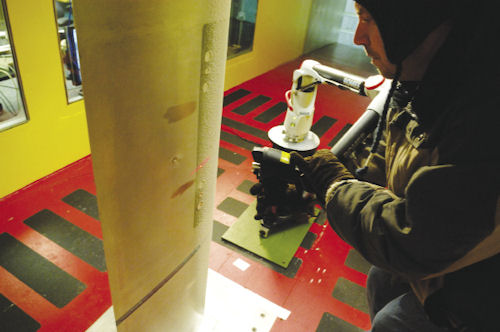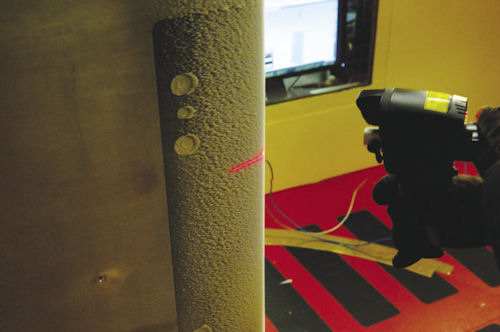July 1, 2013
By Cathy Hayat
Air travel has long been considered the safest form of transportation. Statistically speaking, the average American is safer in an airplane than an automobile. Though reassuring, the industry is relentlessly pursuing ways to improve air travel safety.One such improvement is the continued research to further understand ice buildup and how it affects aerodynamics. The aerospace industry has focused on understanding ice accretion because it causes a reshaping of the aircraft’s wings or tail. When this occurs, there is the danger of aerodynamic stall.
 The ROMER Absolute Arm is used to scan the accreted ice on the leading edge of an aircraft wing model. |
The point at which a stall takes place involves the contour of the airfoil. A small amount of ice build-up, as slight as the roughness of sandpaper, will affect the way air flows over the upper surface. This reduces lift and increases drag to the point of which a stall becomes imminent.
According to the Aircraft Icing Research Alliance (AIRA), a cooperative association comprised of European, Canadian and U.S. government agencies, icing is the most critical natural hazard affecting the safe operation of aircraft in the Northern Hemisphere. Though aircraft routinely operate in icing environments, the dynamics of icing are still not fully understood. Areas of concern include atmospheric conditions that lead to aircraft icing, the variability of icing conditions and aircraft performance in icing conditions.
Another area of concern is the capability to simulate ice accretions and their aerodynamic effects to forecast equipment’ behavior. It is this concern that has benefitted from the introduction of metrology tools to simplify reverse engineering of ice shapes.
Studying the Ice
Engineers in the Icing Branch at NASA’s Glenn Research Center in Cleveland have been studying the mechanics of ice buildup since the 1940s. In the past 20 years, the team’s objective was to document 3D features of the wing and tail shapes with a laser scanner. They hoped to use a solution that was starting to find its way into mainstream industry to capture the data. Their plan was to develop methods for evaluating and simulating the growth of ice on aircraft surfaces, the effects ice may have on the behavior of aircraft in flight, and the behavior of ice protection and detection systems.
Unfortunately, the researchers could not find a system that performed to their requirements. This was partly because the available hardware did not have the capability to capture the finer nuances of the ice shapes. It was also because available software could not capture the scan data and generate a CAD model with an adequate amount of detail.
Undaunted, the team continued to pursue the concept of ice forecasting. They learned that it is an extremely complicated process, because the physics of icing are not well documented nor understood. If the team could not rely on a digital solution, they needed to find a manual one, even if the results could not be quantified. Their short-term solution was to produce castings that recreated the features of ice shapes.
To create the castings, the team accreted ice on the wing or tail section’s leading edge. After the ice is acquired, the leading edge is installed in a mold box. Room Temperature Vulcanizing (RTV) silicone that cures below freezing temperatures is poured into the box and left overnight to cure. A polyurethane casting resin is poured into the mold to accurately duplicate the ice shape. The casts are then used in qualitative analysis by attaching them to wing models and testing them in flight or in a wind tunnel to measure how much performance degradation they cause.
At the team’s disposal is NASA’s Icing Research Tunnel (IRT) at Glenn. The IRT is one of the world’s largest refrigerated wind tunnels, with a 6x9x20 ft. test section, and the capability to generate airspeeds of more than 400 mph.
Implementing Metrology
NASA has been tasked with creating software to help predict ice growth. These efforts are aimed at the development of design and analysis tools that can aid aircraft manufacturers, subsystem manufacturers, certification authorities, the military and other government agencies in assessing the behavior of aircraft systems in an icing environment.
 A researcher uses the ROMER Absolute Arm to capture the finer details of the ice shapes. |
To do so, the researchers revisited the subject of acquiring quantitative data using non-contact laser scanning. They believed technology had finally caught up with their requirements, after thoroughly evaluating several laser scanning systems by testing them in the wind tunnel with actual ice.
In the end, the team decided a portable coordinate measuring machine (CMM), specifically a Romer Absolute Arm with integrated laser scanner, was the solution that best fit their needs. The stiff carbon fiber construction eliminates the need for temperature compensation because, for this application, it is routinely used in an environment where temperatures range from 0 ° to 28 °F. Using equipment that is thermally stable also prevents the system from locking up when temperatures rapidly change.
Using the new equipment, the team changed their procedure. After accreting ice, a researcher brings the portable CMM and computer into the wind tunnel. The ice is painted with a custom titanium dioxide fast-evaporating paint. While maintaining temperatures of 0 ° to 30 °F, the operator scans the ice using a slow, smooth motion.
“One factor that we did not want to compromise was the ergonomics of the system, especially in such a challenging environment,” notes Sam Lee, a research engineer with a Glenn contractor. “If the scanner starts to feel heavy, the researcher’s hands would tremble, which negatively influences the data.”
The scanning process takes approximately 15 to 20 minutes, and requires an overlap between individual scan passes. However, the researchers needed to avoid scanning the same area multiple times, which can add unwanted noise to the acquired data. The difficulty in scanning the shapes is ensuring all the small gaps within them are measured. When the scan is complete, the researchers have between a 0.5 to 1.0GB data file. They are able to scan up to seven ice shapes during a day of testing, because of the time it takes to initially accrete the ice.
Although the specifications of the portable CMM boast far better accuracies, this was not a primary concern for NASA because the tolerances the team needs to achieve are between four and five thousandths of an inch. The importance of the work is not the absolute accuracy, but in capturing the finer details of the ice shapes. In this application, the laser scanner’s resolution of 0.046 mm between points allows them to document those details.
The mold and casting method provides excellent results; however, the process is extremely tedious and time-consuming. One of the biggest benefits when reverse engineering with a laser scanner is the savings on time and materials.
“The process of making molds and castings is very labor-intensive,” Lee adds. “To make one cast shape takes a couple of days in terms of man-hours. Now, it takes a couple of hours to scan and process the ice shape.”
Although the savings are a definite benefit, faster data acquisition is the most important gain. Using quantifiable data in their computer models further refines the program’s accuracy.
The Next Step
At press time, the researchers are comparing the scan data vs. the mold and casting method in preliminary studies. To compare the two side by side, several ice shapes were scanned, as well as reproduced with the mold and cast method. A 3D rapid prototype machine recreated the shapes using the scan data.
The team is testing both shapes in an aerodynamic wind tunnel to discover whether the outcome is identical. At this point, the results for straight wings are similar, as researchers have recorded similar penalties created by both sets of ice shapes. They base their findings on the amount of lift and drag observed. If the results continue to be similar, laser scanning has the potential to replace the mold and casting method used for more than 20 years to capture aerodynamically relevant features of ice shapes.
“Based on preliminary testing, we have been getting very similar results,” Lee reports. “Additionally, the casting method has an inherent flaw: It tends to make the ice shape rougher due to the small air bubbles that get trapped in the mold. So the molds we create are a little rougher than the actual ice.”
Comparison testing recently concluded, and at press time NASA was preparing to publish the results. At present, there are several wind tunnels owned and operated by companies in the aerospace industry. While these researchers continue to use metrology to enhance ice forecasting software, others in the aerospace industry may discover new uses for the methods and techniques pioneered by NASA.
Cathy Hayat is a marketing specialist for Hexagon Metrology, a global provider of products and services for industrial metrology applications in sectors such as automotive, aerospace, energy, and medical.
More info
Subscribe to our FREE magazine, FREE email newsletters or both!






